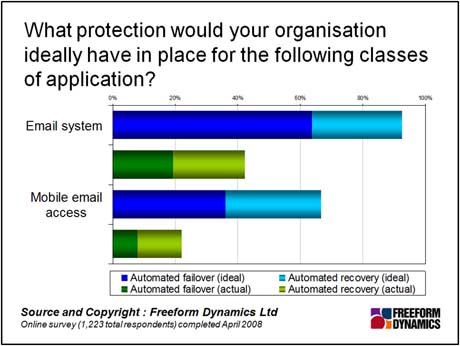by Martin Atherton
For most businesses, IT is linked to multiple facets of activity: product design, marketing, online sales, customer service, to name a few. It makes little sense to divorce the notion of IT from the business as a whole. A natural reaction in toughening times is to do this though, and IT is often high on the list for budget culls. A more pragmatic view is to consider that as customers become more discerning, it is vital that a business presents itself as being easy to engage with, always available, and able to offer high quality, responsive customer service.
Against this background and with this pragmatic approach in mind we shall discuss application resilience, with a focus on email and the smaller business.
When 1,200 IT professionals were asked about the frequency with which IT systems failures impact their businesses, more than half stated that disruptions occurred on at least a monthly basis. Beyond this, one in five suffers brand damage or tangible financial loss on at least a quarterly basis. This is no minor matter, then.
When we examine where the hotspots are in terms of different application types, larger enterprises tend to identify core business applications as an Achilles heel. However, small and medium-sized organisations call out horizontal applications such as email as being particularly troublesome from an availability perspective, as a result of the difficulties in keeping up with the necessary investment in platforms (Figure 1).
While it is easy to take applications such as email for granted, there is a relationship between the size of an organisation and the its relative importance to everyday operations – not just internal communications – but communicating with customers, prospects and partners. The smaller the organisation, the more critical email becomes. The importance is obvious if processes depending on it as their primary link to the outside world are considered in terms of importance to the business: generating quotes, sending and receiving purchase orders, updating customers – the list is endless.
Without even realising it, many smaller organisations have built a raft of applications and processes which surround and rely on email. When all is well, email is a key business enabler, when it goes down, it can turn into a major bottleneck, and represent a significant risk to business as a whole.

Figure 1
Email is an availability hotspot for small and medium businesses.
Our research findings show (Figure 2) that when it comes to application resiliency, existing measures taken to protect email systems bear little resemblance to an ‘ideal scenario’. The reasons for this boil down to (1) a lack of emphasis on protection when planning the implementation of new systems, and (2) organisations missing a vital point: protection can be applied selectively, where it will have most value. For many businesses it is seen as an all or nothing approach, and when time to delivery is critical, often ignore protection and resilience as superfluous ‘additional features’ until it is too late, as a significant proportion of the research sample told us.

Figure 2
The gap between what the business needs and what is actually in place is very clear.
The bottom line is that many organisations may have an opportunity to optimise their efforts when it comes to protecting the applications they rely on. Furthermore, because email systems are relatively standalone, ‘retrofitting resilience’ can be achieved with significantly less work that say, reworking a large scale, bespoke application.
The smaller the organisation, the more relative value email represents in terms of doing business efficiently, and therefore it should be treated accordingly when it comes to protection. This inside track article is based on a recent research project carried out by Freeform Dynamics entitled ‘Risk and Resilience: The application availability gamble’.
Through our research and insights, we help bridge the gap between technology buyers and sellers.





Have You Read This?
From Barcode Scanning to Smart Data Capture
Beyond the Barcode: Smart Data Capture
The Evolving Role of Converged Infrastructure in Modern IT
Evaluating the Potential of Hyper-Converged Storage
Kubernetes as an enterprise multi-cloud enabler
A CX perspective on the Contact Centre
Automation of SAP Master Data Management
Tackling the software skills crunch